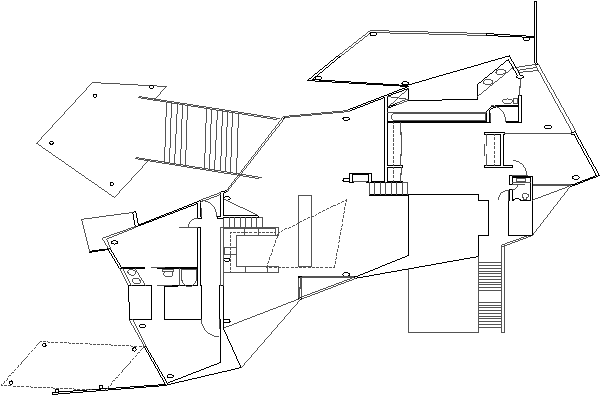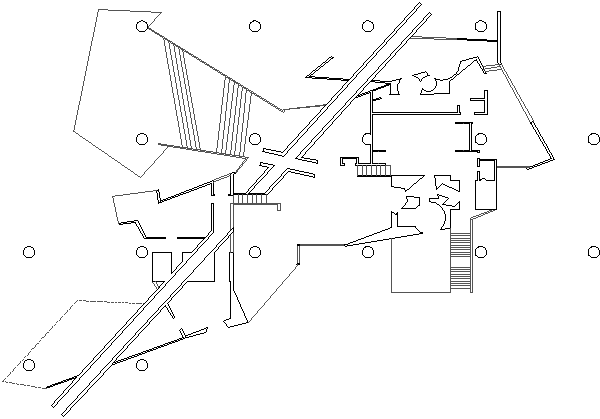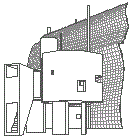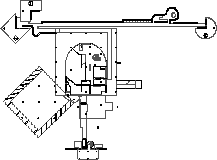2011.01.14 12:02
7 Wonders (and a half) of POSTMODERN architecture?
Charles Holland at Fantastic Journal:
b-sides
I'm currently involved in writing a book re-appraising architectural Post Modernism. It's top secret, hush-hush. Part of it contains a top ten of Po-Mo moments, which I realise makes it sound like a rather ugly box of chocolates. Anyway, now that the final mix has been agreed I thought I'd share a few of the ones that didn't make the final cut.
Anyway, here's a selection of 'id' moments:
Gooding House aka Weight-Watchers House
Ur-Ottopia House
Good-Bye House
Gooding Trice House
Gooding Trice Villa
Psycho-Suburban Pochè
2011.02.11 10:40
TOP 10 MUST HAVE ARCHITECTURE BOOKS
Le Corbusier, Oeuvre Complète 1957-65.
Dal Co and Forster, Frank O. Gehry: The Complete Works.
John Hejduk, Adjusting Foundations.
El Croquis 131/132 and El Croquis 134/135 (OMA/AMO/Rem Koolhaas).
James Stirling - Michael Wilford & Associates: la Nuova Galleria di Stato e Stoccarda.
van Berkel and Bos, MOVE.
Liane Lefaivre, Leon Battista Alberti's Hypnerotomachia Poliphili.
Oppositions 18.
Lotus International 35 or Learning from Las Vegas (first edition).
Luigi Ficacci, Piranesi: The Complete Etchings.
2011.09.12 11:46
What would happen if you mix two master architects with opposing styles?
Le Corbusier - Kahn
Le Corbusier - Venturi
Schinkel - Trumbauer - Hejduk - Stirling
early Le Corbusier - late Le Corbusier
Le Corbusier - Hejduk
Mies van der Rohe - Hejduk
2011.11.12 10:04
Quondam's Fifteenth Anniversary
I read Sanford Kwinter's "Mack 1 (and Other Mystic Visitations)" last night and early this morning. Back in mid-October 1997, instead of going to the opening of Guggenheim Bilbao, Kwinter and Reiser went to a reenactment--the fiftieth anniversary reenactment of Yeager's October 14, 1947 breaking of the sound barrier. Kwinter calls the event a "commemorative re-enaction, of perhaps the second most significant accomplishment in the history of twentieth-century space," and, because architects did not somehow latch on to this accomplishment (back in the late 1940s), late twentieth-century architectural accomplishments like Guggenheim Bilbao are not as important as they seem. Apparently, architecture missed the real Zeitgeist "boat," however, and most thankfully, a reenactment can come to the rescue.
After reading, a few things started entering my mind, like didn't John Hejduk's Silent Witnesses architecturally address this very Zeitgeist? It's hard to grasp the impact of Silent Witnesses by just the images within The Mask of Medusa, but I still vividly remember seeing the models in person at Cooper Union (Spring Break, 1977). Hejduk definitely did not miss the boat, or the submarine, or the lunar module.
| |
2011.12.07 12:24
Frank Gehry
[Y]ou are correct, I do not mean "pliability/pliancy only in literal surface-curving manner," but more of a "yielding readily" (like the varying aspects of the plan of the Wagner House which is on a sloped site). Perhaps it is uncannily (or even appropriately) ironic that the Venturi and Rauch peeling wall detail yeilds from an actual bending wall.
I (re)read about 75% of Lynn's essay last night, and there one sees "the pliant" more in the sense of literal bending and folding, plus also more in concert with suppleness and smoothness--although here too Gehry's architecture is most often used as example. (I feel my reading last night suffered a bit due to no illustrations accompaning this latest version of the essay.)
[T]he pliancy of the Palace of Ottopia is more a demonstration of the drawing pliancy that "laissez-faire" CAD manipulation allows. Yes, the Danteum is there, but so is Hejduk's Bye House, a bit of Perruzzi's Palazzo Massimo and a little bit of myself. (There are several animations of how the design came together which I'll again upload.) Also, the gemmating Danteum plans allude to Eisenman (Aronoff).
Interestingly, within the studies for the Palace of Ottopia, there are some (pliant CAD) manipulations of Gehry's Wagner House--

--which eventally became House for Otto 4.

--which eventally became House for Otto 4.
| |
2012.01.30 14:44
Narrative in architecture / landscape?
Ah yes, Rita Novel. What an apt name for such a paramount figure within the contemporary realm of narrative in architecture.
Regarding the Danteum, see how it fits within the overall sequential/narrative formula of the promenade architecturale: 3122z through to 3123l.
And there's Piranesi's Ichnographia Campus Martius--"While representing a reenacted plan of ancient Rome's Field of Mars, Piranesi ingeniously delineates two narratives--that of pagan Rome and that of Christian Rome--and at the same time offers an unprecedented lesson in urban design.
Within the Ichnographia Campus Martius there is the "Pagan - Christian Triumphal Way," which also fits within the sequential/narrative formula of the promenade architecturale noted above, and there is "Eros et Thanatos," starting at 2683 and going through to 2683l.
I'd also consider looking at John Hejduk's Adjusting Foundations--a somewhat more inscrutible narrative, but almost ceaselessly compelling nonetheless. It's a book I've yet to tire of "reading," although I rarely pay any attention to the words.
2012.09.30 16:51
I too have been following...
...I too have been following the latest 'designs' featured at Archive of Affinities, and I'm somewhat reminded of some of the 'designs' that came out of Quondam between 1999 and 2008. Seeing as you see the designs from Archive of Affinities as 'atemporality at work', I'm curious what you might think of the (not all too dissimilar) designs at Quondam.
Go and check out the following: Ur-Ottopia House, Ludi 002, Good-Bye House, Mikveh PMP, Dominican Fortress, Mosque Q, House of Shadows Bye, Gooding Trice House, Le Composites, Cut & Paste Museum, Headquarters of D.A.T.A., Villa Plus Ultra, Courthouse Plus Ultra.
With a few exceptions, the buildings are 're-combined' at the same scale, and offer an 'other' (fictional?) rendition of architectural history. If nothing else, I'd like to have a better focus of what it is exactly that these building designs might represent--postmodernity or perhaps atemporality.
2012.12.19
Wave Wall House 2
 2410
2410
| |
2012.12.24 17:08
23 December
[Divine Comedy], Terragni, Hejduk, Eisenman, Koolhaas, (via extruded collages) Libeskind, Quondam 3300u
2013.02.13 14:13
13 February / On Courthouse Plus Ultra
3301p
2013.06.07
Villa Appositional
 2425
2425
2013.06.07 19:08
7 June - Villa Appositional
3703j
|